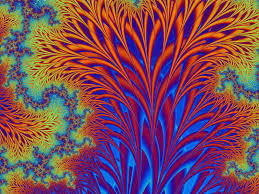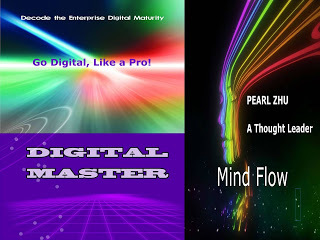Pearl Zhu's Blog, page 1371
January 17, 2016
Conventional Wisdom or Unconventional Wisdom: Which is True Wisdom
 People do have their own beliefs and practices, which one can call as Conventional Mind. And one has right to live with the same. With age one tends to become risk averse, so they have tendency to stick to the conventional wisdom. Unconventional wisdom often means the fresh insight or “out of box” thinking, so conventional wisdom or unconventional wisdom, which is true wisdom?
People do have their own beliefs and practices, which one can call as Conventional Mind. And one has right to live with the same. With age one tends to become risk averse, so they have tendency to stick to the conventional wisdom. Unconventional wisdom often means the fresh insight or “out of box” thinking, so conventional wisdom or unconventional wisdom, which is true wisdom?The logical mind is not equal to a conventional thinking. Conventional mind is bound by its beliefs and general practices. We have to be determined to get better results somehow and it will help us to try unconventional practices and a better result. Conventional thinking often refers to “in-the box” thinking, which is opposite to the “out-of-box” creative thinking, The logical mind is more structured in the solution hunt, whereas the innovative mind is faster to test new untested areas. The more structured approach means that the discerning and mature thinker with a logical or structure style will first approach the problem from all possible conventional methods, most times in simulations; identify problem areas, choose solutions and move forward. The logical mind can be also creative when necessary. It is only when all known avenues have been thought through, that the logical mind will start the out-of-the-box thinking. This is a far superior and more stable method in most situations; the intuitive mind is faster to perceive, solve; it is quick in decisions; but suffers from the weakness of fast thought - which has its own risk side, as there is a tendency to be fast but not thorough - which is why at times innovations fail despite being brilliant in conceptual thought.The issue is that with the conventional mind you expect unconventional results. This is like walking on the treadmill. Taking steps, getting stressed but not moving ahead...wondering what is happening...
Being unconventional does not mean being foolish, neither being conventional means one is wise: Often at the society with traditional culture, it usually considers conventional to be wise, and unconventional to be unwise. So, we keep preaching with the age old wisdom. But in more open culture, conventional wisdom has a negative connotation about sticking to the outdated concepts, traditions, cultures, or the old ways to do things. And, with being called conventional wisdom we keep nurturing mediocrity and keep expecting Innovation out of that mediocrity. The same mediocrity is inherited down the line by generations. Some crisis situations, often with more frequent disruptions in digital era, will require innovative process; where a conventional style would be troublesome. That is a given; the ideal scenario is a judicious and mature mix of both styles. Ideally, an organisation will, by choice, build a mix of styles in the optimal proportion as dictated by its realities and its industry.
 Conceptually, balance is the key. An innovative mind don’t do different things, they do things differently. Innovation often means to mix something new with old. But, in reality, to apply balance would require a very high level of awareness. This is about maturity and discernment. The unconventional wisdom comes from the balance of analytics and intuition, thinking fast and slow. Analysis just leads to a balancing “act,” which is like a “see-saw.” But, the real balance achieved is an outcome of inner awareness. You are sure of what you are doing. Awakened – will win. An innovative culture will entertain the "impossible," not out of passive hope but out of active intention. We have to act differently to get a different result which may not be easy by a conventional mind.
Conceptually, balance is the key. An innovative mind don’t do different things, they do things differently. Innovation often means to mix something new with old. But, in reality, to apply balance would require a very high level of awareness. This is about maturity and discernment. The unconventional wisdom comes from the balance of analytics and intuition, thinking fast and slow. Analysis just leads to a balancing “act,” which is like a “see-saw.” But, the real balance achieved is an outcome of inner awareness. You are sure of what you are doing. Awakened – will win. An innovative culture will entertain the "impossible," not out of passive hope but out of active intention. We have to act differently to get a different result which may not be easy by a conventional mind.
Either conventional or unconventional, the true wisdom leads to putting more thought into things and searching for flaws in decisions and that widens the possibility of coming up with alternative solutions. Wisdom is at the top of knowledge life cycle: the abundance of data, information and knowledge is not automatically equal to the abundance of wisdom. Many times, wisdom is still in scarcity, for human as species to survive and thrive, the true wisdom is the most important thing to push the world forward
Follow us at: @Pearl_Zhu
Published on January 17, 2016 23:50
Three Characteristics of Digital Organizations
 Digital organizations are hyper-connected and interdependent, so they can continue to adapt to the “VUCA” digital new normals. With the fast pace of changes and emerging digital technologies such as “SMAC,” companies large or small are also brainstorming and experimenting the next generation of organizational structure design, to improve employees’ engagement, productivity, as well as creativity across the enterprise ecosystem. So what are the important characteristics of digital organizations?
Digital organizations are hyper-connected and interdependent, so they can continue to adapt to the “VUCA” digital new normals. With the fast pace of changes and emerging digital technologies such as “SMAC,” companies large or small are also brainstorming and experimenting the next generation of organizational structure design, to improve employees’ engagement, productivity, as well as creativity across the enterprise ecosystem. So what are the important characteristics of digital organizations?
Adaptability: A digital organization starts with a transcendent purpose that leads to a unique natural design, a design most fit to achieve the purpose of businesses. A digital organization is a living business which is organic, alive, and holistic, vibrant, energetic, responsive, fluid, and innovative, in relationship with its environments, customers, suppliers, and above all enhances and supports the creative human spirit. Enterprises also have always been parts of simple and complex ecosystems, so to function seamlessly, an enterprise has to be linked to the many and varying touch points between itself and its marketplace environment. Therefore, you have to look holistically at the problem domain to architect and design an adaptive organization to address business and system dynamics.
People Centricity: One key determinant of whether an organization can move to new digital structure is the development level of its people. So people have to be ready to move to a more fluid structure. A digital, people-centric organization needs to embrace: Engagement - to engage employees more in contributing both strategy planning and implementation Enablement - to enable the culture of innovation; empowerment - to empower employees to be who they want to be and well align their professional development with business’s goals and long term strategy, and to Enchant - customers via digital touchpoints and tailored experiences. The real digital shift means principles over rules, empowerment over control, outside-in customer oriented, and dynamic over static.
 Antifragility: Digital organizations are organic, complex, and living. And a complex system is not necessary complicated system with restricted regulations. or policies. But complex systems are full of interdependencies, hard to detect and nonlinear responses, the simpler and the better. Digital organization as a whole is anti-fragile, with better ability to tolerate volatility, it means that the hard from errors should be less than the benefits.The complication of traditional, hierarchical organizations are caused by layering, fractal structure, treating a business organism like a simple machine with kind of reductionism, mechanism, or approximation, etc. While anti-fragility implies, contrary to initial instinct, is beyond resilience or robustness, so it can better adapt to the business nature of complexity and interdependence, and lift organizational maturity more significantly.
Antifragility: Digital organizations are organic, complex, and living. And a complex system is not necessary complicated system with restricted regulations. or policies. But complex systems are full of interdependencies, hard to detect and nonlinear responses, the simpler and the better. Digital organization as a whole is anti-fragile, with better ability to tolerate volatility, it means that the hard from errors should be less than the benefits.The complication of traditional, hierarchical organizations are caused by layering, fractal structure, treating a business organism like a simple machine with kind of reductionism, mechanism, or approximation, etc. While anti-fragility implies, contrary to initial instinct, is beyond resilience or robustness, so it can better adapt to the business nature of complexity and interdependence, and lift organizational maturity more significantly. A digital organization can bring greater awareness of intricacies and the systemic value of organizational systems. business process, people dynamics, resource alignment, or technological touches. The challenge is to have a harmonized vision about organizational structure, organizational capabilities, and business maturity, still, people are the focal point of any business design, with the ultimate goals to improve business productivity, agility, and encourage innovation as well. Follow us at: @Pearl_Zhu
Published on January 17, 2016 23:48
January 16, 2016
Three Traits to Bridge Digital and Global Leadership Gaps
 We are at the age of digital dawn, now the physical barriers can no longer be the walls to separate people from communicating and sharing knowledge and insight, are we on the way to recognize the best of the best, or simply blend the variety of perspectives into the new ideas and solutions, and more critically, how to bridge global leadership gaps, and develop the new generation of digital leaders and managers who can gain respect, and win hearts and minds not just locally, but globally?
We are at the age of digital dawn, now the physical barriers can no longer be the walls to separate people from communicating and sharing knowledge and insight, are we on the way to recognize the best of the best, or simply blend the variety of perspectives into the new ideas and solutions, and more critically, how to bridge global leadership gaps, and develop the new generation of digital leaders and managers who can gain respect, and win hearts and minds not just locally, but globally?
From in-depth knowledge to Abstract wisdom: Knowledge can be defined as the capacity for learning, reasoning, understanding, and similar forms of mental activity; aptitude in grasping truths, relationships, facts, meanings, etc. At digital age, knowledge life cycle is significantly shortened, it means today’s digital leaders MUST be life learner with cognitive agility and profundity of understanding. Knowledge is power, today’s leaders need to have expertise in their own professions to practice knowledge power more persuasively, and connect the minds more intelligently. Even going beyond, today’s global leaders should have abstract wisdom. Statistically, there are roughly 6500 languages in the world and there are about 4200 religions around the globe, so the challenge is to unify, not divide, being a multilinguistic is definitely helpful, but it’s still limited. Therefore, abstract wisdom can bridge the difference, because at a higher level, as many times abstraction enables agreement. You must communicate, communicate and then communicate and understand that not all of the associates will move through the change curve at the same speed. Just because you have arrived at the other side does not mean everyone else has. Take proposed approach from abstraction to elaboration...A wide leader does not just follow but discover the path. All of the different approaches are out there to suit different minds to learn. Wisdom is the application of knowledge suitable to the time and situation, to be wise you need all the knowledge you can get if there is enough, and then capture insight and foresight from it. Wisdom is not knowledge; one cannot have wisdom without knowledge, but one cannot substitute wisdom for knowledge as well.
From heart-feeling compassion to mind-connecting empathy: Heart feeling compassion is important to feed the hunger and help the helpless...But mind-connect empathy will help identify the root causes of many man-made calamities, and advance human society via understanding and harmony. Empathy is the power of understanding and imaginatively entering into another person's feelings; or the intellectual identification with or vicarious experiencing of the feelings, thoughts, or attitudes of another. Empathy means using the right language with the right people."Nothing in the world, in business or in life, is black and white. It could be hinting at another important skill for great leaders, which is respecting other people as if you were in their position. It means the thoughtfulness of not only knowing what to say, what not to say, also how to say, and when to say it. Digital is the age with increasingly more complex and pressing problem-situations, embedded in interconnected systems operating in dynamically changing environments. In addressing these problem situations and working with their relevant systems, we have learned to recognize the limitations of the perspectives, methods, and tools of the traditional scientific orientation. Every serious problem we face today as a species has been caused by human dysfunction or destructiveness. And human dysfunction and destructiveness are caused by the interaction of hidden (intangible and invisible) human affective, cognitive, imaginative and connotative functions and content. In other words, the wrong focus, the wrong values, the wrong assumptions, the wrong means. Framing the new mind to see the ever changing world via the multi-dimensional lenses, empathy is absolutely one of the most critical elements of digital leadership, it means an open mind to understand how others think and value; it means proactively gaining cognizance of your environment and adapt to it means thoughtfulness, intelligence, and influence in positive ways.
 From Creativity flow to innovation fine-tuning: Creativity is emerged as one the top leadership qualities. Global leadership is shifting toward grooming historic digital leadership skills embodying effective communication in networks of global conversations that inspires creativity in diverse domains of expertise.Creative leaders are futuristic and forward thinking. Realizing that what has worked in the past isn't today's best solution and having the vision to see what it has now become. Creative leaders are the one who are capable of predicting future trends, manage the presence and delegate the past. In each context, a creative leader is always conscious of the changes needed to connect the past with the future, prospecting and communicating tangible such as resources and intangible such as cultural changes needs and identifying the proper vision for each cycle in the life of a corporation.Creative leaders are adaptable. Creative leadership is being flexible enough to adapt to the situation and the players involved. It means doing unexpected, unconventional things or methods to connect with your team, organization or beyond--whatever it takes to get the job done, done well and leaving everyone feeling good about it. The more "creative leaders" we have, the better for the world. The proper function, the ultimate criterion of "creative leadership," is the ability to create more leaders, to spread leadership, to bridge leadership gaps, and inspire creativity - or, more precisely, to groom "followers" (the people for whom one is responsible) into leaders. Stated differently, "creative leadership" is the ability to develop the people for whom one is responsible into leaders in their own right.
From Creativity flow to innovation fine-tuning: Creativity is emerged as one the top leadership qualities. Global leadership is shifting toward grooming historic digital leadership skills embodying effective communication in networks of global conversations that inspires creativity in diverse domains of expertise.Creative leaders are futuristic and forward thinking. Realizing that what has worked in the past isn't today's best solution and having the vision to see what it has now become. Creative leaders are the one who are capable of predicting future trends, manage the presence and delegate the past. In each context, a creative leader is always conscious of the changes needed to connect the past with the future, prospecting and communicating tangible such as resources and intangible such as cultural changes needs and identifying the proper vision for each cycle in the life of a corporation.Creative leaders are adaptable. Creative leadership is being flexible enough to adapt to the situation and the players involved. It means doing unexpected, unconventional things or methods to connect with your team, organization or beyond--whatever it takes to get the job done, done well and leaving everyone feeling good about it. The more "creative leaders" we have, the better for the world. The proper function, the ultimate criterion of "creative leadership," is the ability to create more leaders, to spread leadership, to bridge leadership gaps, and inspire creativity - or, more precisely, to groom "followers" (the people for whom one is responsible) into leaders. Stated differently, "creative leadership" is the ability to develop the people for whom one is responsible into leaders in their own right.
If leadership is influence and discipline, then digital and global leadership is a ‘meta-influence” and trans-disciplinary practice, from culture empathy to intelligence; from respect to empowerment, from creativity to inspiration, it is not only about art and science; but also about the attitude, altitude, and aptitude of authentic leadership. The substance of leadership will never change, it is about the direction to change, the vision to make the positive influence, the dedication to contribute, and the creativity to do things differently, in order to lead your organization and the world forward.
Follow us at: @Pearl_Zhu
Published on January 16, 2016 23:06
Three Agile Aspects in Strategy Execution
 Making strategy is important because it navigates organizations toward the right direction for businesses’ long-term success, but strategy execution is more challenging because it consumes so many resources, business /human capitals, and there are so many pitfalls or hidden risks for doing it effectively. Execution has seemingly increased in priority as the result of the rising frequency of digital disruption and turbulence today. So how to apply agile philosophy to manage strategy execution more effectively?
Making strategy is important because it navigates organizations toward the right direction for businesses’ long-term success, but strategy execution is more challenging because it consumes so many resources, business /human capitals, and there are so many pitfalls or hidden risks for doing it effectively. Execution has seemingly increased in priority as the result of the rising frequency of digital disruption and turbulence today. So how to apply agile philosophy to manage strategy execution more effectively?
Agile as a management principle: Agile is about considering and measuring human imperfection and the non-deterministic factors of a category of endeavors of which product is part of. Agile practice can help anyone or any group focus their attention effectively and take right action towards a vision in manageable segments where risk, uncertainty, unknowns and fast moving markets are involved. Agility is the ability to think and act promptly to the ever changing environment. A successful strategy execution needs to have well thought-out plans, prepare “what if” scenarios, analyzing impacts on customers and competitions, and planning for multiple forks in the road for quick agile ability to react. That said, Strategy execution scenario should embrace agile philosophy. Strategy execution will keep the speed at sync, and strategic planning and execution should keep both long term view with the short-term urgency.
Agility as productivity multipliers: Besides managers seeking to be enlightened, the agility can be productivity multipliers by eliminating impediments; understand the fundamentals of core agile principles which are not only in the spirit of Agile, but in a sense serve as a mature cornerstone of its implementations, they should also understand the fundamentals of creation of value, constraints, etc. Whether you have Agile teams or not, you still need to have management discipline and, if you prefer, leadership. It’s important to apply agile principles to make the linkage between strategy and execution and create more resource engagement because it should be clearer to people how their work impacts the organization, to improve engagement, and increase productivity as well.
 Agile as an improvement principle: Strategy execution will almost always change the way the organization operates, in order to align it with the defined strategic direction. Such change will always provoke some measure of resistance, particularly if the organization is large, traditional, has enjoyed success in the past, and has strong bargaining power with its customers. The success of strategy management undoubtedly lies in “timely execution,” and it can only be achieved through continuous persistence, improvement and following up. The employees will likely question the wisdom of changing what they perceive to be the "formula for success." It will take a strong transformational leader to demonstrate that the status quo is not a viable option, to show a new path that will lead to greater success via the set of agile principles.
Agile as an improvement principle: Strategy execution will almost always change the way the organization operates, in order to align it with the defined strategic direction. Such change will always provoke some measure of resistance, particularly if the organization is large, traditional, has enjoyed success in the past, and has strong bargaining power with its customers. The success of strategy management undoubtedly lies in “timely execution,” and it can only be achieved through continuous persistence, improvement and following up. The employees will likely question the wisdom of changing what they perceive to be the "formula for success." It will take a strong transformational leader to demonstrate that the status quo is not a viable option, to show a new path that will lead to greater success via the set of agile principles. Strategy execution takes both management disciplines and business capabilities. agility is the key success factor in dynamic execution because it help set business priority right, build the culture of improvement, having the ability to adapt to changes, so execution can produce the expected results in the context of the strategic choices. Follow us at: @Pearl_Zhu
Published on January 16, 2016 23:04
January 15, 2016
The Weekly Insight of the “Future of CIO” 1/15/2016
 The “Future of CIO” Blog has reached 1.2 million page views with 2300+ blog posting in 59+ different categories of leadership, management, strategy, digitalization, change/talent, etc. The content richness is not for its own sake, but to convey the vision and share the wisdom. Here is the weekly insight of the “Future of CIO” blog for the second week of 2016.
The “Future of CIO” Blog has reached 1.2 million page views with 2300+ blog posting in 59+ different categories of leadership, management, strategy, digitalization, change/talent, etc. The content richness is not for its own sake, but to convey the vision and share the wisdom. Here is the weekly insight of the “Future of CIO” blog for the second week of 2016.
The Weekly Insight of the “Future of CIO” Blog 1/15/2016Digital Master One-Year Anniversary Sum Up Slides, Video, Blogs: The purpose of “Digital Master” is to envision the multidimensional impact that digital philosophy, technology, and methodology will have on the future of business and human society.
2016 Digital Mind Crafting Slideshare, Blog Sum Up, Video: We have moved into the deep, deep digital age when information is abundant and where creativity becomes a baseline competency. The pace of change is so rapid that no one can rest on a static mindset, past accomplishments, or the wishful thought that everything is perfect the way it is. Indeed, mindset is far more important than talent. Talent can always be developed by those with an open and right mindset.
Three Characteristics of DIgital Strategy? Digital strategy planning is a living process, and a good strategy is not “superficial,” it needs to dig deeper and diagnose the root causes of emergent business issues, because digital organization is a part of the dynamic business ecosystem that connects digital dots or resources inside and outside of the organization to create values for customers. So the piecemeal strategy of bolting digital channels to the business is no longer sufficient, and digital strategy needs to be shifted from top-down one-way direction to organizational inclusion, from static and linear strategy-execution scenario to dynamic strategy execution continuum; from a single strategy documentation often put on the shelf to an ongoing strategy portfolio. More specifically, what are the characteristics of an executable digital strategy?
 Three Practices of Digital Innovation Generally speaking, innovation is to transform novel ideas to achieve their business values. It is not a serendipity, but a discipline and a set of practices to achieve business goals. Innovation helps to tackle the complexities of business dynamic in the digital ecosystem, but often within itself, it needs to change and improve as well. Therefore, digital paradigm shift also includes the perspective of building a scalable innovation environment or innovation ecosystem. It is crucial to fine tune innovation processes, capabilities, and develop a set of practices to manage innovation portfolio more effectively.CIO’s Digital Agenda XXX: The Pitfalls to Avoid in Digital Transformation: Digital transformation is a thorny journey, there are many roadblocks on the way, and numerous pitfalls lead to the failure, so how to identify and avoid them in order to drive digital transformation effortlessly?
Three Practices of Digital Innovation Generally speaking, innovation is to transform novel ideas to achieve their business values. It is not a serendipity, but a discipline and a set of practices to achieve business goals. Innovation helps to tackle the complexities of business dynamic in the digital ecosystem, but often within itself, it needs to change and improve as well. Therefore, digital paradigm shift also includes the perspective of building a scalable innovation environment or innovation ecosystem. It is crucial to fine tune innovation processes, capabilities, and develop a set of practices to manage innovation portfolio more effectively.CIO’s Digital Agenda XXX: The Pitfalls to Avoid in Digital Transformation: Digital transformation is a thorny journey, there are many roadblocks on the way, and numerous pitfalls lead to the failure, so how to identify and avoid them in order to drive digital transformation effortlessly?Blogging is not about writing, but about thinking and innovating the new ideas; it’s not just about WHAT to say, but about WHY to say, and HOW to say it. It reflects the color and shade of your thought patterns, and it indicates the peaks and curves of your thinking waves. Unlike pure entertainment, quality and professional content takes time for digesting, contemplation and engaging, and therefore, it takes time to attract the "hungry minds" and the "deep souls." It’s the journey to amplify diverse voices and deepen digital footprints, and it's the way to harness your innovative spirit.
Follow us at: @Pearl_Zhu
Published on January 15, 2016 23:25
Are you Part of Problems or Part of Solutions
 Businesses and the world as a whole become over-complex with increasing speed of changes. Some say the lack of problem-solvers is a problem for this world, more specifically, can you define the right problems, and solving them in the right way? From business management perspectives, some organizations waste much time and tens of thousands of dollars reacting to problems/challenges, but never really solving anything only creating more problems. So as digital leaders or professionals, what’s your reflection-Are you part of problems or part of solutions?
Businesses and the world as a whole become over-complex with increasing speed of changes. Some say the lack of problem-solvers is a problem for this world, more specifically, can you define the right problems, and solving them in the right way? From business management perspectives, some organizations waste much time and tens of thousands of dollars reacting to problems/challenges, but never really solving anything only creating more problems. So as digital leaders or professionals, what’s your reflection-Are you part of problems or part of solutions?
We all develop reputations - for being problem creators, problem definers or problem solvers: Take this question with you and observe scenarios and ask yourself this very question: How do you discover the part you played in the problem/challenge? People develop regular roles, with regular scripts, and the challenge for leaders is to move others to being problem solvers. Indeed to move beyond merely solving problems to pursuing opportunities. We need to listen and understand before acting, and constantly learn and educate/share. Understand the situation, understand the people working with us as well as the people receiving the "solution," understand expectations from each group involved, understand motivation drivers, understand how everyone is integrated to the solution, understand and differentiate the results from the impacts to ensure the engagement, seek for leveraging previous experience and understand how to optimize each one strength to create a dynamic group where roles changes.
 When problems arise, it’s usually best to pause and reflect before reacting: There's a neurological basis for this approach. In short, when pausing you are giving your brain time to move beyond the initial emotional reaction and apply some analytical thinking to the issue. In many situations this will clarify the part you have played in the problem... and that’s a great place to start fixing it!So often is the case, it is your own reaction to problems/challenges that is the problem/challenge. Anger in many situations is detrimental on many levels. Anger is definitely a problem/challenge we face. Often times, we are unaware of how we are adding to the problem/challenge of anger.
When problems arise, it’s usually best to pause and reflect before reacting: There's a neurological basis for this approach. In short, when pausing you are giving your brain time to move beyond the initial emotional reaction and apply some analytical thinking to the issue. In many situations this will clarify the part you have played in the problem... and that’s a great place to start fixing it!So often is the case, it is your own reaction to problems/challenges that is the problem/challenge. Anger in many situations is detrimental on many levels. Anger is definitely a problem/challenge we face. Often times, we are unaware of how we are adding to the problem/challenge of anger.
We need to take guides development and progress within ourselves. Reflecting on our own actions, taking responsibility for those actions and understanding the interventions. Encouraging the same approach within others to face their own responsibilities enables them to reflect, take responsibility and determine their own interventions and to progress. This is a leadership approach - encouraging others to reflect and intervene when they would not have done so of their own volition is effectively leading change. That change is effected in another person and thus they are changed through our leadership.
There is an importance of introspection to assess the part you played in the problem. No one person or entity is always the source of problems, likewise, no one person will be the panacea to problems, but with teamwork, amicable solutions can be achieved. As leaders, it is vital that you develop and maintain emotional competence skills if you are to be effective. It is easy for us to observe how other people become emotionally charged and reactive to problems/challenges; it's even easier for ourselves to become ignited/emotionally charged and reactive towards problems/challenges; and even simpler to just blame someone else, group of people, etc, and wait for someone else to "fix the problem." Unfortunately, this has become a habit; along with the false belief that the "other people must change." The only person we CAN change is ourselves.
By being empathetic to others and an understanding person, you will have a passion for what you’re doing, in which others can tell. Your passion will show others you truly want and desire the best outcome possible. Additionally, this will help others to see you want the best outcome for yourself, team, and organization, which will make it easier for others to honestly reach out and give their advice. Listen to what others are saying and get others talking about what’s going on. Ask for others feedback in what they believe the problem to be but also be prepared to hear something you might not like or agree with. Understand when you’re upset or angry, you’re not effectively listening, which requires some emotional intelligence to be able to recognize when you’re in such a situation. Learn from the past problems and challenges along with encouraging other to learn from the problems that have happened, and believe that problems are the opportunity to show others you're a good problem-solver. In addition, it is important to develop the willingness to take ownership, otherwise it could lead to a defensive mindset and result in failing to identify the role in problem/challenge.
It takes critical thinking to frame the right problem and empathetic thinking to address the correct need. Problem solving is about seeing a problem and actually finding a solution to that problem.When you can put ourselves in a self aware position of experiencing/seeing/hearing all sides of a problem/challenge, it actually helps opens your eyes, ears, minds and hearts too. Develop the capacity to use a flashlight on yourselves. This provides you more self-awareness leading to more humility in seeing the reality in its true form. It also takes collective thinking and collaborative mindset to brainstorm the solutions.
Follow us at: @Pearl_Zhu
Published on January 15, 2016 23:22
Is Going Digital a No-Brainer
Going digital is not enough, and being digital is not a status quo.
 The shift to digital cuts across sectors, geographies, and leadership roles, the digital transformation is now spreading rapidly to enable organizations of all shapes and sizes to reinvent themselves. The point is if going digital is a no brainer, then why are so many companies still overly reliant on paper? Why then are so many companies not taking advantage of customer-facing opportunities to digitize interactions with SMAC technologies? Why then are so many companies not apply technology to fully digitize business processes and important business capabilities? Or what are the causes that the majority of organizations are digital mediocre or laggard, only very small percentage of organizations are high-mature digital master?
The shift to digital cuts across sectors, geographies, and leadership roles, the digital transformation is now spreading rapidly to enable organizations of all shapes and sizes to reinvent themselves. The point is if going digital is a no brainer, then why are so many companies still overly reliant on paper? Why then are so many companies not taking advantage of customer-facing opportunities to digitize interactions with SMAC technologies? Why then are so many companies not apply technology to fully digitize business processes and important business capabilities? Or what are the causes that the majority of organizations are digital mediocre or laggard, only very small percentage of organizations are high-mature digital master?
Such digital debate is intended to help leaders understand what's required and how as a high-level basis of going digital mean to the business: It is not just about any fancy digital technologies or pretty web presences. Many organization are still confused digital with general technology adoption. Going digital in one's business implies first going digital internally culturally. For that, processes need to be not just online but internally socially visible. It’s that what triggers employees to start adopting transparency and social decision making while being evaluated by peers in real time. When one extends that to the first line of customers, the impact is manifold. Disruptions such as these are critical to induct non social employees into a new digital paradigm. When people from top-down and bottom up are equipped with digital minds, and then digital starts permeating into the daily tasks and underlying processes, and change is more sustainable, and digital flow becomes the nature of business.
Being digital means to fine tuning the digital ecosystem to become more innovative, . Constantly improve the business and seeing change as an opportunity while keeping a holistic overview of the business are the core messages of the text. The thing that needs some figuring out is how to integrate modern technologies such as social, mobile, analytics and cloud (SMAC) to a business."That applies to "going digital." It applies just the same to using prestressed concrete as opposed to brick and mortar, as an example. A company that is not reaping the benefits of the digital age in the year of 2015 has a fundamental problem: Failure to adapt and innovate. "Going digital" won't help against that, a general change of attitude is required. Otherwise the company will sooner or later be history.
 Make investment on the top priorities of business and focus on digitizing the fundamental nature of enterprises or businesses. This shows that business need to focus on what changes/technology needs to be adopted and what needs to just bypassed. There have been changes all along, although the pace of disruption is very high this time around. By focusing on the technology relevant to the business an organization would embark on the right path towards changing with times. It enables key digital capability building to help an organization adapt to changes in a timely, effective, and sustainable way when the dynamic circumstances require it.
Make investment on the top priorities of business and focus on digitizing the fundamental nature of enterprises or businesses. This shows that business need to focus on what changes/technology needs to be adopted and what needs to just bypassed. There have been changes all along, although the pace of disruption is very high this time around. By focusing on the technology relevant to the business an organization would embark on the right path towards changing with times. It enables key digital capability building to help an organization adapt to changes in a timely, effective, and sustainable way when the dynamic circumstances require it.
Going digital is not enough, and being digital is not a status quo. Froming going to digital to being digital needs to take a lot of brainstorming and thought-out planning. At a high maturity level, organizations have to stretch out in every business dimensions for driving the full-fledged digital transformation more confidently and radically.
Follow us at: @Pearl_Zhu
 The shift to digital cuts across sectors, geographies, and leadership roles, the digital transformation is now spreading rapidly to enable organizations of all shapes and sizes to reinvent themselves. The point is if going digital is a no brainer, then why are so many companies still overly reliant on paper? Why then are so many companies not taking advantage of customer-facing opportunities to digitize interactions with SMAC technologies? Why then are so many companies not apply technology to fully digitize business processes and important business capabilities? Or what are the causes that the majority of organizations are digital mediocre or laggard, only very small percentage of organizations are high-mature digital master?
The shift to digital cuts across sectors, geographies, and leadership roles, the digital transformation is now spreading rapidly to enable organizations of all shapes and sizes to reinvent themselves. The point is if going digital is a no brainer, then why are so many companies still overly reliant on paper? Why then are so many companies not taking advantage of customer-facing opportunities to digitize interactions with SMAC technologies? Why then are so many companies not apply technology to fully digitize business processes and important business capabilities? Or what are the causes that the majority of organizations are digital mediocre or laggard, only very small percentage of organizations are high-mature digital master?Such digital debate is intended to help leaders understand what's required and how as a high-level basis of going digital mean to the business: It is not just about any fancy digital technologies or pretty web presences. Many organization are still confused digital with general technology adoption. Going digital in one's business implies first going digital internally culturally. For that, processes need to be not just online but internally socially visible. It’s that what triggers employees to start adopting transparency and social decision making while being evaluated by peers in real time. When one extends that to the first line of customers, the impact is manifold. Disruptions such as these are critical to induct non social employees into a new digital paradigm. When people from top-down and bottom up are equipped with digital minds, and then digital starts permeating into the daily tasks and underlying processes, and change is more sustainable, and digital flow becomes the nature of business.
Being digital means to fine tuning the digital ecosystem to become more innovative, . Constantly improve the business and seeing change as an opportunity while keeping a holistic overview of the business are the core messages of the text. The thing that needs some figuring out is how to integrate modern technologies such as social, mobile, analytics and cloud (SMAC) to a business."That applies to "going digital." It applies just the same to using prestressed concrete as opposed to brick and mortar, as an example. A company that is not reaping the benefits of the digital age in the year of 2015 has a fundamental problem: Failure to adapt and innovate. "Going digital" won't help against that, a general change of attitude is required. Otherwise the company will sooner or later be history.
 Make investment on the top priorities of business and focus on digitizing the fundamental nature of enterprises or businesses. This shows that business need to focus on what changes/technology needs to be adopted and what needs to just bypassed. There have been changes all along, although the pace of disruption is very high this time around. By focusing on the technology relevant to the business an organization would embark on the right path towards changing with times. It enables key digital capability building to help an organization adapt to changes in a timely, effective, and sustainable way when the dynamic circumstances require it.
Make investment on the top priorities of business and focus on digitizing the fundamental nature of enterprises or businesses. This shows that business need to focus on what changes/technology needs to be adopted and what needs to just bypassed. There have been changes all along, although the pace of disruption is very high this time around. By focusing on the technology relevant to the business an organization would embark on the right path towards changing with times. It enables key digital capability building to help an organization adapt to changes in a timely, effective, and sustainable way when the dynamic circumstances require it.
Going digital is not enough, and being digital is not a status quo. Froming going to digital to being digital needs to take a lot of brainstorming and thought-out planning. At a high maturity level, organizations have to stretch out in every business dimensions for driving the full-fledged digital transformation more confidently and radically.
Follow us at: @Pearl_Zhu
Published on January 15, 2016 23:20
Digital Master Sum Up to Celebrate One-Year Anniversary
 Digitalization opens the new chapter of innovation, it connects silos, across walls, seas, and the planet, as the notion of “digitalization” is now affecting all aspects of business operations from within and around business ecosystem, to customer engagement, business models, and processes, and no industry is exempt. It also raises questions about leadership, strategy, culture, talent management and almost everything else. So How to run a high-effective and high-mature digital organization with the very nature of digital “persona” and high influence? From an organizational development perspective, what would be the digital dimensions to harness its unique strength and styles? And how to find tune a digital master? Here is the Sum Up posting to celebrating one-year anniversary of “Digital Master” publishing:
Digitalization opens the new chapter of innovation, it connects silos, across walls, seas, and the planet, as the notion of “digitalization” is now affecting all aspects of business operations from within and around business ecosystem, to customer engagement, business models, and processes, and no industry is exempt. It also raises questions about leadership, strategy, culture, talent management and almost everything else. So How to run a high-effective and high-mature digital organization with the very nature of digital “persona” and high influence? From an organizational development perspective, what would be the digital dimensions to harness its unique strength and styles? And how to find tune a digital master? Here is the Sum Up posting to celebrating one-year anniversary of “Digital Master” publishing:
Digital Master Sum Up Slides, Video, Blogs: The purpose of “Digital Master” is to envision the multidimensional impact that digital philosophy, technology, and methodology will have on the future of business and human society.
Digital Master Holiday Intense-Tuning Chap I: The Future of Digital Organization Organizational Development helps organizations become more mature by providing an environment within which employees at all levels are inspired and allowed to commit their best in the organization's service. This is definitely a leadership challenge because effective leaders inspire that commitment habitually. However, in most of organizations, leadership of that ilk is in short supply. What's the digital vision of business leaders and how to clearly define the business goals of such organizational tuning?
Digital Master Intense Tuning Chap II: Digital Mind Crafting: Mindset is far more important than talent. Talent can always be developed by those with an open and right mindset. In chapter II of Digital Master, we introduce the 15 decoded ultramodern digital mindsets,
Digital Master Chap 3: Five Points of Digital Strategy: A definition for paradigms generally found is A worldview underlying the theories and methodology of a particular subject. A digital paradigm is an emerging digital ecosystem of principles, policies, and practices that set limits or boundaries; and also offer the guidance for problem-solving or creating something new under the digital rules. It is the transformation that is reshaping our thinking and recasting the way we view ourselves, the systems of which we are the part of the environments in which we live, and the way we view the world.
Chap IV: How to Assess your Organization’s DNA? There are many culture metaphors, such as culture is like soil, the glue, the fabric or the mixing colors of paint, and the DNA of the business. The word “culture” stems from a latin root that means the tilling of the soil. A company’s culture helps define what a company is like - what it means to be part of the organization; how to act as a team or teams; and what others in the company believe and strive for, and even how the outsiders see the company - the business brand. So in order to optimize or rebuild a strong digital culture, the organization first needs to know how to assess its organization’s DNA more objectively and systematically via the set of questionnaire
Digital Master Chap V: Three Debates about Business’s Digital Capabilities. Business capability, in general, is defined as the ability to perform or achieve certain actions or outcomes through a set of controllable and measurable faculties, features, functions, processes, or services. It is the ability of the business to consistently deliver an expected result. Organizational capabilities are delivered when various resources work together for a purpose to achieve an outcome. And the organization’s digital capabilities are business competency to execute its digital strategy and deliver value to its customers. Here are three debates brainstormed in the book of “Digital Master” to further clarify and deepen the understanding about business capabilities which underpin strategy execution.
Digital Master Ch VI: Three Characteristics of Digital Innovation? Digital is the age of customer empathy. Being customer centric is the prerequisite to becoming a Digital Master. Organizations large or small are on the journey to digital transformation. Is it reaching the inflection point for organizations to become a customer-centric business, Customer Experience is no long just a single department's job, but a collaborative effort from IT to marketing, from HR to contact center, what will be the top priorities of Customer Experience Management strategically and tactically in the new year?
Digital Master Ch VII: Digital Intelligence? We live in the world with the explosive data and the abundance of information. Every day, more than 2.5 quintillion bytes of data are created through a range of activities. And the average business expects to spend $8 million on data-related initiatives in recent years. So how to manage data, information, knowledge, and mind flow, to build a high-intelligent and high-effective organization - The real Digital Master?
Digital Master Ch VIII: How to Manage Digital Workforce Effectively? People are always the most invaluable asset in organizations. However, the varieties of industry surveys continuously show that more than two-thirds of employees do not feel engaged in the work; and more than 50% of senior executives across industries believe that their organizations have not fully leveraged the power of digitalization in HR and talent management. Thereby, it is emphasizing the strategic imperative and critical need for changes. So what’s the People 2.0 all about to drive a behavioral, cultural, and educational transformation by new technological paradigms and fine tune the true Digital Masters?
 Digital Master Ch IX: Five Aspects of Digital Maturity? Digital makes a profound impact from specific functions to business as a whole. the purpose of such radical business transformation is to make significant differences in the overall levels of customer delight and achieve high performing business result for the long term. The shift to digital cuts across sectors, geographies and leadership roles, and it is now spreading rapidly to enable organizations of all shapes and size to reinvent themselves. Here are five perspectives of digital maturity
Digital Master Ch IX: Five Aspects of Digital Maturity? Digital makes a profound impact from specific functions to business as a whole. the purpose of such radical business transformation is to make significant differences in the overall levels of customer delight and achieve high performing business result for the long term. The shift to digital cuts across sectors, geographies and leadership roles, and it is now spreading rapidly to enable organizations of all shapes and size to reinvent themselves. Here are five perspectives of digital maturity
Many organizations are at the inflection point of digital transformation journey, either be a disrupter or being disrupted, digital makes significant impacts on every aspect of the business from people, process to technology and capability both horizontally and vertically. Organizations of the future are increasingly exhibiting digital characteristics in various shades and intensity. Being digital, not just doing digital; digital maturity matters, it’s the core shift in how the business operates, the philosophy and methodology, the leadership and strategy; the mindset and culture, and it is the time to craft a new year digital resolution for your organization.
Digital Master Featured URLs:Digital Master Presentation, Introduction, Fun Quiz on SlideshareDigital Master Author Home PageDigital Master on Future of CIO BlogDigital Master at FlipboardDigital Master at TwitterDigital Master on LinkedinGoodreads Author’s Home PageDigital Master Introduction on YoutubeDigital Master Online Order Links:Digital Master on AmazonDigital Master on B&NDigital Master on Apple iTunesDigital Master on LuLuDigital Master on Google BooksDigital Master on KOBODigital Master on FeedbooksDigital Master on BOL
Follow us at: @Pearl_Zhu
Published on January 15, 2016 14:36
January 14, 2016
CIO’s Digital Agenda XXXIII: CIO’s Digital Leadership
 The “Future of CIO” Blog has reached 1.2 million page views with about 2300+ blog posting in 59+ different categories of leadership, management, strategy, digitalization, change/talent, etc. The content richness is not for its own sake, but to convey the vision and share the wisdom. Although the “DNA of CIO” is still a bit stereotypical from varying industry surveys, the digital trend is that more and more CIOs have diversified experience and colorful background, working across-functional and industrial boundaries, from technologists to artists; from entrepreneurs to consultants, from business strategist to talent manager. CIO’s Digital Leadership The Digital-Savvy CIO: Modern CIOs face many challenges, it is not sufficient to only keep the light on. Regardless of which industry or the nature of organization you are in, being a digital leader will need to master the art of creating unique, differentiating value from piles of commoditized technologies, but more specifically, what are the digital-savvy CIOs doing to run IT as a value creator and innovation engine? The point is what are the skills and capabilities of the future of CIOs? And how can CIOs practice digital leadership more effectively?The Changing Role of CIO: With the consumerization of IT and other emerging digital technology trends such as Cloud, mobile, social and analytics, the role of IT is at the inflection point to go digital. IT shouldn’t be just satisfied with the surviving mode, it has to be thriving, and CIO roles is also changing from an infrastructure IT manager to 'keep the light on' to a wise business strategist/solution advisor/consultant to create value for the organization and make leadership influence across functions and beyond.
The “Future of CIO” Blog has reached 1.2 million page views with about 2300+ blog posting in 59+ different categories of leadership, management, strategy, digitalization, change/talent, etc. The content richness is not for its own sake, but to convey the vision and share the wisdom. Although the “DNA of CIO” is still a bit stereotypical from varying industry surveys, the digital trend is that more and more CIOs have diversified experience and colorful background, working across-functional and industrial boundaries, from technologists to artists; from entrepreneurs to consultants, from business strategist to talent manager. CIO’s Digital Leadership The Digital-Savvy CIO: Modern CIOs face many challenges, it is not sufficient to only keep the light on. Regardless of which industry or the nature of organization you are in, being a digital leader will need to master the art of creating unique, differentiating value from piles of commoditized technologies, but more specifically, what are the digital-savvy CIOs doing to run IT as a value creator and innovation engine? The point is what are the skills and capabilities of the future of CIOs? And how can CIOs practice digital leadership more effectively?The Changing Role of CIO: With the consumerization of IT and other emerging digital technology trends such as Cloud, mobile, social and analytics, the role of IT is at the inflection point to go digital. IT shouldn’t be just satisfied with the surviving mode, it has to be thriving, and CIO roles is also changing from an infrastructure IT manager to 'keep the light on' to a wise business strategist/solution advisor/consultant to create value for the organization and make leadership influence across functions and beyond.
The CIO as a Digital Orchestra Conductor? It was possibly Peter Drucker who first said a manager's role was that of a "Symphony Orchestra Conductor." In this highly complex and competitive digital dynamic business environment, this description fits in today for any business leader or a manager in an operational or even functional role in any successful organization, particularly when matrix organizations are more in play.
Should a CIO be a General Manager of IT or a SME of all IT Domains? Today’s CIOs have multiple roles to play and take broader leadership responsibilities in transforming their organizations. Should a CIO be a general manager of IT or a subject matter expert (SME) of all IT domains?
 What are the most Important Skills for the CIO of the Future? IT is at the cross-road, should it continue to be run as the cost center to keep the light on, or should it move up the maturity level –to become the value creator or even a game changer for the business. If so, what are the most important business skills for the CIO of the future? What are the important technical skills for the CIO of the future? What are those synthetic capabilities or unique skills which can differentiate a modern digital CIO from a traditional industrial CIO?
What are the most Important Skills for the CIO of the Future? IT is at the cross-road, should it continue to be run as the cost center to keep the light on, or should it move up the maturity level –to become the value creator or even a game changer for the business. If so, what are the most important business skills for the CIO of the future? What are the important technical skills for the CIO of the future? What are those synthetic capabilities or unique skills which can differentiate a modern digital CIO from a traditional industrial CIO?
CIO’s Profession, Perception, and Progression? Compared to other CXOs, CIO role is considerably new with less than three decades history, however, due to the changing nature of technology, omnipresence of technology and abundance of information, the IT leadership role continues to be reimagined, refined, refreshed, and reenergized, here are three Ps of CIO: Profession, Perception, and Progression.
Blogging is not about writing, but about thinking; it’s not just about WHAT to say, but about WHY to say, and HOW to say it. It reflects the color and shade of your thought patterns, and it indicates the peaks and curves of your thinking waves. Unlike pure entertainment, quality and professional content takes time for digesting, contemplation and engaging, and therefore, it takes the time to attract the "hungry minds" and the "deep souls." It’s the journey to amplify your voice, deepen your digital footprints, and match your way for human progression.Follow us at: @Pearl_Zhu
Published on January 14, 2016 22:55
Three Characteristics of Digital Workforce
 Digital organizations are always on, interdependent and hyper-connected, people are always the most important asset in any organization before, today, and future. However, compared to a traditional workforce, the digital workforce is a new breed - the super Connected generation with a multitude of varieties - multi-generations, multi-cultures, and multi devices.
Digital organizations are always on, interdependent and hyper-connected, people are always the most important asset in any organization before, today, and future. However, compared to a traditional workforce, the digital workforce is a new breed - the super Connected generation with a multitude of varieties - multi-generations, multi-cultures, and multi devices.
Growth Mindset: Digital is the age of abundance of information and clicks away knowledge, it means the shortened knowledge life cycle and fierce talent competition.s In the industrial era, fixed mindsets are okay to survive because the business and world are slow to change. However, at the age of digitalization with increasing velocity and rapid changes, a growth, even an accelerated mind is strategic imperative to adapt to changes, enjoys new thinking. As changes are expedited for both individual and business, neither business nor life is linear these days, the capabilities to adapt to unpredictable, ride above the learning curve are critical to making continuous improvement and smooth digital transformation. At the organizational level, the digital business environment is dynamic and uncertain, growth and innovation are heavily dependent on having the right people with growth mind in the right places at the right time. Therefore, it’s also strategic to build a positive environment and culture of learning where people can develop and learn more rapidly and dare to be different. That is the power of digital workforce.
Connect-wise: Digital also means hyperconnectivity. Social platforms provide unprecedented opportunities for people all over the world to share, brainstorm, and co-creative knowledge. Driven by strategic necessity, digital technologies, and cultural progress, the digital workforce today are divergent in many ways, share a natural affinity for new perspectives, innovations, and collective wisdom. However, being connect-wise means to discern the trend or fad, seek business values before taking business initiatives, the goal of such business connectivity is to unify the best of the best, shift the old way of thinking, and accelerate innovation via broad-based communication and collaboration.

Change/innovation capability: Either at the individual or organizational level, change capability becomes a key differentiator between digital leaders and laggards. Develop change capability in those who’ll help drive and deliver changes, also, consider the capability or ability of those impacted by the change to handle its impacts. That being said, recognize your change agents and change champions, because they will serve the organization with more energy and determination. But also identify the “change resistors,” if someone is “resisting” change, what’s that all about? Are they perhaps only get used to “certainty,” or “stability,” or is there something else? Or they may just try to alert sponsors to poorly thought-out change plan, and they have better ideas? Change is not for its own sake, People work best and remain engaged and satisfied when work empowers and enables them to be fully who they are. Therefore, it’s critical to build up a transformational workforce with the collective capability to adapt to changes.
Digital organizations today need to redefine themselves where talent can develop and learn more rapidly than anywhere else. Digitalization has erased the line between business brand and talent brand, as they are two sides of the same coin now. So businesses must be alert to the digital dynamic environment, adapt their workforce planning and development strategies to ensure their digital workforce is engaged, innovative and transformative. Follow us at: @Pearl_Zhu
Published on January 14, 2016 22:52



